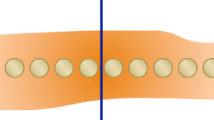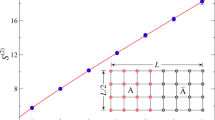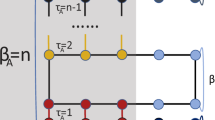Abstract
Ground-state entanglement governs various properties of quantum many-body systems at low temperatures and is the key to understanding gapped quantum phases of matter. Here we identify a structural property of entanglement in the ground state of gapped local Hamiltonians. This property is captured using a quantum information quantity known as the entanglement spread, which measures the difference between Rényi entanglement entropies. Our main result shows that gapped ground states possess limited entanglement spread across any partition of the system, exhibiting an area-law scaling. Our result applies to systems with interactions described by any graph, but we obtain an improved bound for the special case of lattices. These interaction graphs include cases where entanglement entropy is known not to satisfy an area law. We achieve our results first by connecting the ground-state entanglement to the communication complexity of testing bipartite entangled states and then devising a communication scheme for testing ground states using recently developed quantum algorithms for Hamiltonian simulation.
This is a preview of subscription content, access via your institution
Access options
Access Nature and 54 other Nature Portfolio journals
Get Nature+, our best-value online-access subscription
$29.99 / 30 days
cancel any time
Subscribe to this journal
Receive 12 print issues and online access
$209.00 per year
only $17.42 per issue
Buy this article
- Purchase on Springer Link
- Instant access to full article PDF
Prices may be subject to local taxes which are calculated during checkout



Similar content being viewed by others
Data availability
No data or code have been generated in this work.
References
Briegel, H. J., Browne, D. E., Dür, W., Raussendorf, R. & Van den Nest, M. Measurement-based quantum computation. Nat. Phys. 5, 19–26 (2009).
Laughlin, R. B. Anomalous quantum Hall effect: an incompressible quantum fluid with fractionally charged excitations. Phys. Rev. Lett. 50, 1395 (1983).
Bardeen, J., Cooper, L. N. & Schrieffer, J. R. Theory of superconductivity. Phys. Rev. 108, 1175 (1957).
Broholm, C. et al. Quantum spin liquids. Science 367, eaay0668 (2020).
Sachdev, S. Quantum phase transitions. in Handbook of Magnetism and Advanced Magnetic Materials (2006).
Hastings, M. B. An area law for one-dimensional quantum systems. J. Stat. Mech. 2007, P08024 (2007).
Arad, I., Kitaev, A., Landau, Z. & Vazirani, U. An area law and sub-exponential algorithm for 1D systems. Preprint at https://arxiv.org/abs/1301.1162 (2013).
Brandão, Fernando, G. S. L. & Horodecki, M. An area law for entanglement from exponential decay of correlations. Nat. Phys. 9, 721–726 (2013).
White, S. R. Density matrix formulation for quantum renormalization groups. Phys. Rev. Lett. 69, 2863–2866 (1992).
Landau, Z., Vazirani, U. & Vidick, T. A polynomial time algorithm for the ground state of one-dimensional gapped local Hamiltonians. Nat. Phys. 11, 566–569 (2015).
Masanes, L. Area law for the entropy of low-energy states. Phys. Rev. A 80, 052104 (2009).
de Beaudrap, N., Osborne, T. J. & Eisert, J. Ground states of unfrustrated spin Hamiltonians satisfy an area law. New J. Phys. 12, 095007 (2010).
Cho, J. Sufficient condition for entanglement area laws in thermodynamically gapped spin systems. Phys. Rev. Lett. 113, 197204 (2014).
Brandão, F. G. S. L. & Cramer, M. Entanglement area law from specific heat capacity. Phys. Rev. B 92, 115134 (2015).
Anshu, A., Arad, I. & Gosset, D. Entanglement subvolume law for 2D frustration-free spin systems. In Proc. 52nd Annual ACM SIGACT Symposium on Theory of Computing (STOC 2020) 868–874 (ACM, 2020).
Anshu, A., Arad, I. & Gosset, D. An area law for 2D frustration-free spin systems. Preprint at https://arxiv.org/abs/2103.02492 (2021).
Aharonov, D. et al. Local tests of global entanglement and a counterexample to the generalized area law. In Proc. 2014 IEEE 55th Annual Symposium on Foundations of Computer Science FOCS14 246–255 (IEEE, 2014).
Sachdev, S. & Ye, J. Gapless spin-fluid ground state in a random quantum Heisenberg magnet. Phys. Rev. Lett. 70, 3339–3342 (1993).
Song, C. et al. Generation of multicomponent atomic Schrödinger cat states of up to 20 qubits. Science 365, 574–577 (2019).
Omran, A. et al. Generation and manipulation of Schrödinger cat states in Rydberg atom arrays. Science 365, 570–574 (2019).
Bluvstein, D. et al. A quantum processor based on coherent transport of entangled atom arrays. Nature 604, 451–456 (2022).
Li, H. & Haldane, F. D. M. Entanglement spectrum as a generalization of entanglement entropy: identification of topological order in non-Abelian fractional quantum Hall effect states. Phys. Rev. Lett. 101, 010504 (2008).
Pollmann, F., Turner, A. M., Berg, E. & Oshikawa, M. Entanglement spectrum of a topological phase in one dimension. Phys. Rev. B 81, 064439 (2010).
Schuch, N., Poilblanc, D., Cirac, J. I. & Pérez-García, D. Topological order in the projected entangled-pair states formalism: transfer operator and boundary Hamiltonians. Phys. Rev. Lett. 111, 090501 (2013).
Cirac, J. I., Poilblanc, D., Schuch, N. & Verstraete, F. Entanglement spectrum and boundary theories with projected entangled-pair states. Phys. Rev. B 83, 245134 (2011).
Kato, K. & Brandão, F. G. S. L. Locality of edge states and entanglement spectrum from strong subadditivity. Phys. Rev. B 99, 195124 (2019).
Dalmonte, M., Vermersch, B. & Zoller, P. Quantum simulation and spectroscopy of entanglement Hamiltonians. Nat. Phys. 14, 827–831 (2018).
Anshu, A., Arad, I. & Jain, A. How local is the information in tensor networks of matrix product states or projected entangled pairs states. Phys. Rev. B 94, 195143 (2016).
Verstraete, F., Murg, V. & Cirac, J. I. Matrix product states, projected entangled pair states, and variational renormalization group methods for quantum spin systems. Adv. Phys. 57, 143–224 (2008).
Hayden, P. & Winter, A. Communication cost of entanglement transformations. Phys. Rev. A 67, 012326 (2003).
König, R., Renner, R. & Schaffner, C. The operational meaning of min- and max-entropy. IEEE Trans. Inf. Theory 55, 4337–4347 (2009).
Berta, M. Single-Shot Quantum State Merging. Master’s thesis, ETH Zurich (2009).
Tomamichel, M. A Framework for Non-Asymptotic Quantum Information Theory. PhD thesis, ETH Zurich (2012).
Hastings, M. B. Lieb-Schultz-Mattis in higher dimensions. Phys. Rev. B 69, 104431 (2004).
Hastings, M. B. & Koma, T. Spectral gap and exponential decay of correlations. Commun. Math. Phys. 265, 781–804 (2006).
Nachtergaele, B. & Sims, R. Lieb-Robinson bounds and the exponential clustering theorem. Commun. Math. Phys. 265, 119–130 (2006).
Lo, H.-K. & Popescu, S. Classical communication cost of entanglement manipulation: is entanglement an interconvertible resource? Phys. Rev. Lett. 83, 1459 (1999).
Coudron, M. & Harrow, A. W. Universality of EPR pairs in entanglement-assisted communication complexity, and the communication cost of state conversion. In 34th Computational Complexity Conference, LIPIcs, Leibniz International Proceedings in Informatics 20 (Schloss Dagstuhl, Leibniz Center for Informatics, 2019).
Harrow, A. W. & Leung, D. W. A communication-efficient nonlocal measurement with application to communication complexity and bipartite gate capacities. IEEE Trans. Inf. Theory 57, 5504–5508 (2011).
Aharonov, D., Arad, I., Landau, Z. & Vazirani, U. The detectability lemma and quantum gap amplification. In Proc. Forty-First Annual ACM Symposium on Theory of Computing STOC’09 417–426 (ACM, 2009).
Arad, I., Landau, Z. & Vazirani, U. Improved one-dimensional area law for frustration-free systems. Phys. Rev. B 85, 195145 (2012).
Bravyi, S., DiVincenzo, D. P., Oliveira, R. & Terhal, B. M. The complexity of stoquastic local Hamiltonian problems. Quantum Inf. Comput. 8, 361–385 (2008).
Chandran, A., Khemani, V. & Sondhi, S. L. How universal is the entanglement spectrum? Phys. Rev. Lett. 113, 060501 (2014).
Araki, H. Gibbs states of a one dimensional quantum lattice. Commun. Math. Phys. 14, 120–157 (1969).
Pérez-García, D. & Pérez-Hernández, A. Locality estimes for complex time evolution in 1D. Preprint at https://arxiv.org/abs/2004.10516 (2020).
Schuch, N., Wolf, M. M., Verstraete, F. & Cirac, J. I. Computational complexity of projected entangled pair states. Phys. Rev. Lett. 98, 140506 (2007).
Kim, I. H. Entropy scaling law and the quantum marginal problem. Phys. Rev. X 11, 021039 (2021).
Arad, I., Landau, Z., Vazirani, U. & Vidick, T. Rigorous RG algorithms and area laws for low energy eigenstates in 1D. Commun. Math. Phys. 356, 65–105 (2017).
Childs, A. M., Su, Y., Tran, M. C., Wiebe, N. & Zhu, S. A theory of trotter error. Preprint at https://arxiv.org/abs/1912.08854 (2019).
Guang H. L. & Wiebe, N. Hamiltonian simulation in the interaction picture. Preprint at https://arxiv.org/abs/1805.00675 (2018).
Berry, D. W., Childs, A. M., Cleve, R., Kothari, R. & Somma, R. D. Simulating Hamiltonian dynamics with a truncated taylor series. Phys. Rev. Lett. 114, 090502 (2015).
Touchette, D. Quantum information complexity. In Proc. Forty-Seventh Annual ACM on Symposium on Theory of Computing STOC ’15 317–326 (ACM, 2015).
Kuwahara, T. & Saito, K. Area law of noncritical ground states in 1D long-range interacting systems. Nat. Commun. 11, 4478 (2020).
Acknowledgements
A.W.H. thanks D. Aharonov for insightful discussions regarding this project and raising the question of connection between the communication complexity of measuring the ground state and ground-state entanglement. A.A. thanks D. Gosset for discussions on the applications of quantum algorithms to area laws. M.S. thanks Z. Landau, A. Natarajan and U. Vazirani for helpful discussions. We thank I. Arad for suggesting the connection between entanglement spread and tensor network contraction. A.A. acknowledges support through the NSF award QCIS-FF: Quantum Computing & Information Science Faculty Fellow at Harvard University (NSF 2013303). Part of the work was done when A.A. was affiliated to the Institute for Quantum Computing and the Department of Combinatorics and Optimization, University of Waterloo, and the Perimeter Institute for Theoretical Physics, where research was supported by the Canadian Institute for Advanced Research, through funding provided to the Institute for Quantum Computing by the Government of Canada and the Province of Ontario. Perimeter Institute is also supported in part by the Government of Canada and the Province of Ontario. A.W.H. was funded by NSF grants CCF-1452616, CCF-1729369 and PHY-1818914; the NSF QLCI program through grant number OMA-2016245; and a Samsung Advanced Institute of Technology Global Research Partnership. M.S. was funded by NSF grant CCF-1729369.
Author information
Authors and Affiliations
Contributions
All the authors contributed equally to all aspects of this work. The authors are arranged alphabetically by last name.
Corresponding author
Ethics declarations
Competing interests
The authors declare no competing interests.
Peer review
Peer review information
Nature Physics thanks Renato Renner and the other, anonymous, reviewer(s) for their contribution to the peer review of this work.
Additional information
Publisher’s note Springer Nature remains neutral with regard to jurisdictional claims in published maps and institutional affiliations.
Supplementary information
Supplementary Information
Supplementary Sections 1–3.
Rights and permissions
Springer Nature or its licensor holds exclusive rights to this article under a publishing agreement with the author(s) or other rightsholder(s); author self-archiving of the accepted manuscript version of this article is solely governed by the terms of such publishing agreement and applicable law.
About this article
Cite this article
Anshu, A., Harrow, A.W. & Soleimanifar, M. Entanglement spread area law in gapped ground states. Nat. Phys. 18, 1362–1366 (2022). https://doi.org/10.1038/s41567-022-01740-7
Received:
Accepted:
Published:
Issue Date:
DOI: https://doi.org/10.1038/s41567-022-01740-7
This article is cited by
-
Entanglement spread is bounded by area
Nature Physics (2022)



